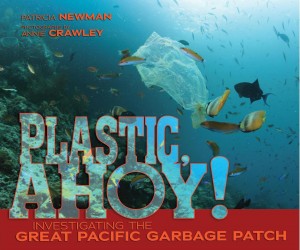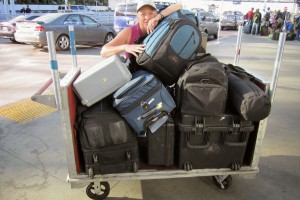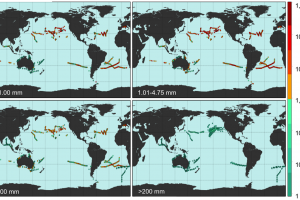To celebrate World Ocean Day, I caught up with Miriam Goldstein, head trash detective in Plastic, Ahoy! Investigating the Great Pacific Garbage Patch. Soon after the SEAPLEX expedition chronicled in my book, Miriam graduated with her Ph.D. from Scripps Institute of Oceanography. Where is she today?
Patricia Newman: How did the 2009 SEAPLEX voyage affect your career in science?
Miriam Goldstein: SEAPLEX pretty much launched my science career. It was an enormous privilege to be able to organize and lead such a huge project while still a graduate student. SEAPLEX data formed the base of my Ph.D. research, and continues to be used in Scripps plastic pollution research. I have also used SEAPLEX communications – the work that Annie and Mario did throughout the voyage – to show how excellent communication could get the public involved in scientific research. And also, it was on SEAPLEX that I fell in love with the open ocean, and with the North Pacific Gyre in particular.
PN: In your opinion, what are the next steps to studying ocean plastic?
MG: We now have a much better idea of just how pervasive plastic pollution is throughout the world ocean, and of the many organisms that are affected by it. I think the next step is understanding how the vast quantities of plastic floating around in the ocean are affecting the ocean’s chemical cycling. Does plastic change how the ocean takes up carbon, or how nutrients move around the food web?
PN: You left the sea for a stint as a legislative fellow for Knauss/SeaGrant. How did that work relate to ocean plastic? And where do you hope that work will take you?
MG: After I finished my graduate work on ocean plastic and got my Ph.D., I moved to Washington DC to work as a Sea Grant fellow on ocean, fishery, and wildlife issues for then-Congressman now-Senator Ed Markey of Massachusetts. I discovered that I really loved working on policy for Congress, so when my fellowship was over at the end of January, I was delighted to have the opportunity to join Congresswoman Jackie Speier’s office as a Legislative Assistant. Congresswoman Speier represents the southern part of the San Francisco Peninsula, with the Bay on one side and the ocean on the other, so it’s a great place for a marine biologist. I don’t do very much work directly related to ocean plastic, but almost everything issue touches on the ocean in one way or another. For example, energy issues touch on climate change, which is having a profound effect on sea life through rising temperatures and through ocean acidification. I don’t know where my career path will ultimately lead, but I am certainly enjoying the ride!
PN: What is the most important finding (in your opinion) to come out of your SEAPLEX voyage since PLASTIC, AHOY!’s publication?
MG: As of now, six scientific papers have been published using SEAPLEX data, and one more – the one about the hitchhikers featured in PLASTIC, AHOY – is undergoing scientific peer review and will hopefully be published soon. I think the most important finding, which is not unique to SEAPLEX but that SEAPLEX research supports, is that plastic pollution is profoundly changing the ocean in unexpected ways. Just one example is our work on sea skaters, a little insect that lives on top of the ocean’s surface. We didn’t go to sea expecting to find that plastic was changing the way that sea skaters lay their eggs, but that is what we eventually found once we knew the right questions to ask. What other questions aren’t we asking yet?
PN: What encouragement would you give to elementary, middle, or high school students interested in science?
MG: Science is getting to poke at cool things for a living, and it’s fantastic! It takes a lot of work to discover something new, that no one has ever known before, but it’s worth it.







Leave a Reply
Your email is safe with me.